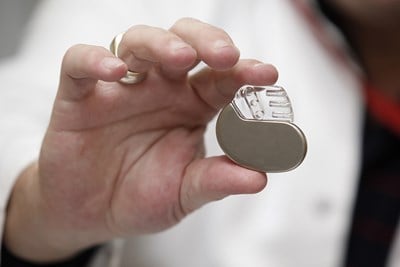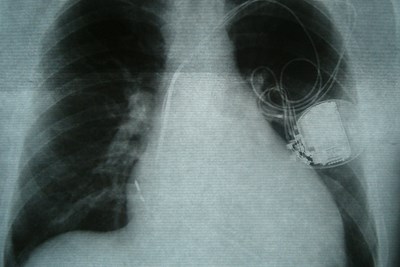Pacemakers are tiny devices implanted in the chest that manage irregular heartbeats, called arrhythmias, and other chronic cardiac issues. They can be used temporarily in emergency situations or on a long-term basis.
The devices work by overriding the natural "pacemaker" that’s in every heart, the sinoatrial node, which sends out an electrical impulse to the chambers of the heart to induce the heartbeat. Depending upon the reason for the implantation of a pacemaker, there are several different types that may be necessary. Here is a look at those different types.
Single Chamber vs. Dual Chamber Pacemakers
Each pacemaker has a series of wires coming out of it, attached to sensors called electrodes. There may be one, two, or three wires, each of which connect the pacemaker to one or more of the four chambers of the heart.
A single chamber pacemaker is only wired to a single chamber —generally the right ventricle (or lower right quadrant)—for problems like atrial fibrillation. A dual chamber pacemaker has two wires; one leads to an atrium and one to a ventricle. This is commonly used for cardiac issues in which the two halves of the heart are not beating in sync.
Cardiac Resynchronization Therapy Device
When three wires extend from the pacemaker, it may also be called a “cardiac resynchronization therapy (CRT) device.” Three of the four chambers are receiving the overriding corrective electrical signal during cardiac resynchronization therapy, in which a pacemaker regulates both ventricles and one atrium.
CRT not only helps the heart beat properly, but also can improve overall blood flow—especially in patients facing heart failure when the two halves of the heart are unsynchronized. This particular technique is relatively new and still under scrutiny, but it has shown promising results.
Demand and Rate-Responsive Pacemakers
After figuring out how many chambers the pacemaker should be attached to for best results, doctor and patient must work together to figure out which type of pacemaker will be more appropriate: one that provides demand or rate-responsive pacing. Most modern pacemakers can be programmed to provide either option.
Demand pacing is used to keep a continuous check on the heart rate. When it begins to beat irregularly, whether too fast or too slow, the pacemaker kicks in and regulates that rhythm.
Rate-responsive pacing monitors more than just the heartbeat. Rather than only focusing on how quickly the heart is beating or constantly overriding the sinoatrial node’s electrical signal to provide a single, steady pace, rate-responsive pacing also checks the respiratory rate and temperature, among other things that indicate periods of higher activity. When increased activity is noted, the rate-responsive programming automatically increases the heart rate to accommodate this.



